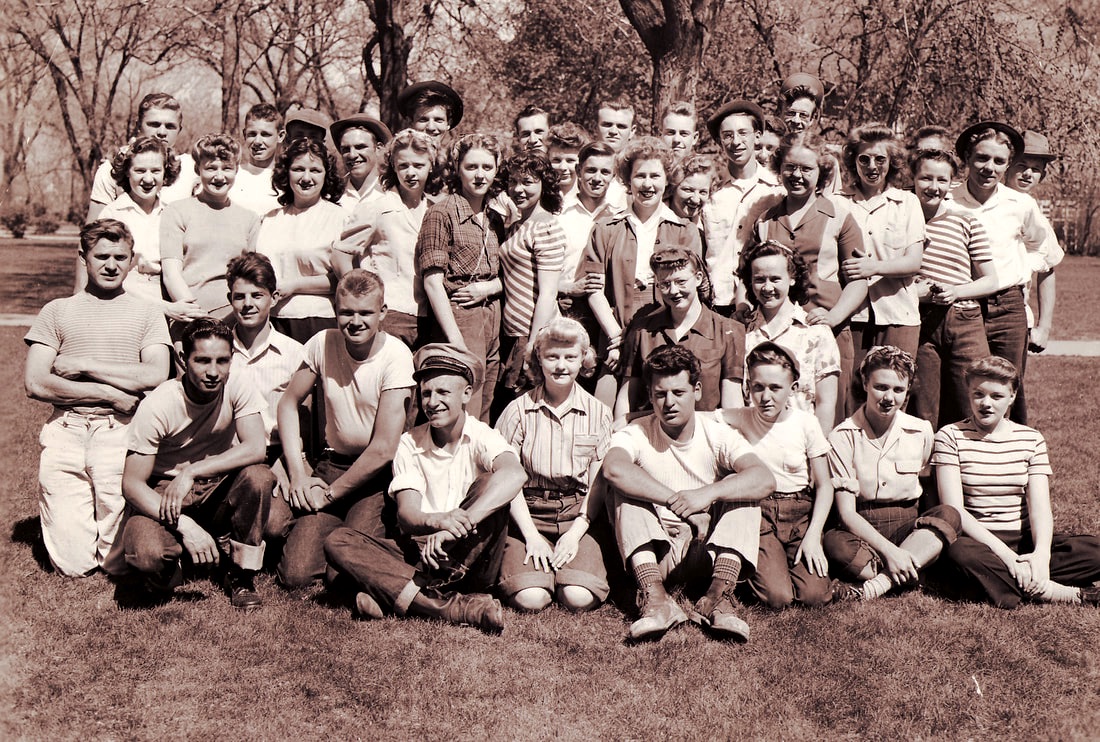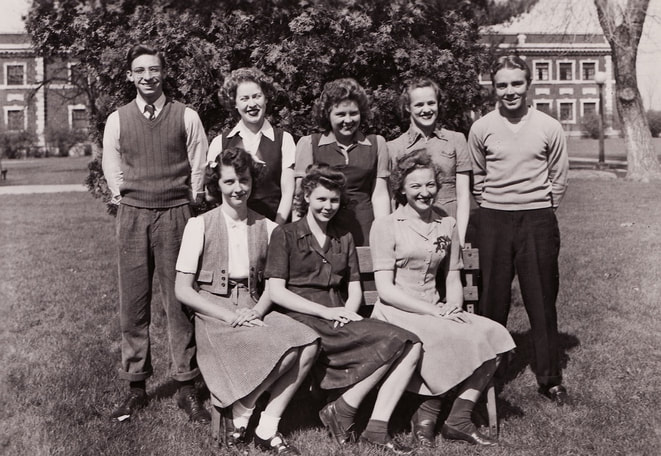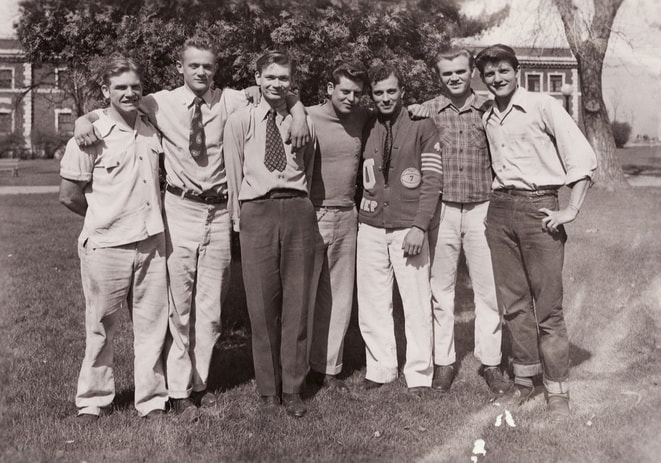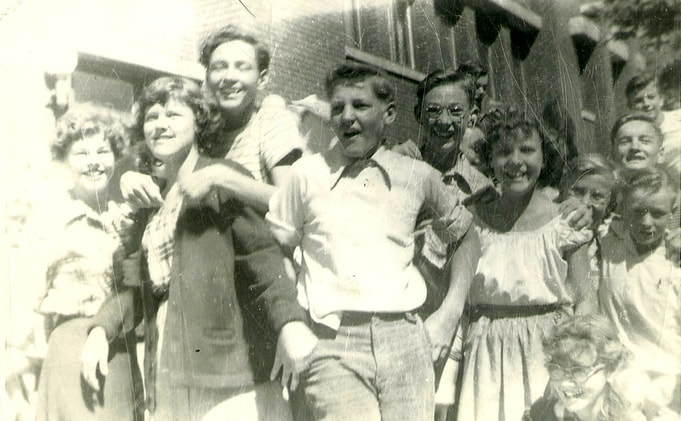The Utah School for the
Deaf Archives
Compiled & Written by Jodi Becker Kinner
Edited by Valarie G. Kinney
Published in 2012
Updaetd in 2024
Edited by Valarie G. Kinney
Published in 2012
Updaetd in 2024
A Brief History of the
Utah School for the Deaf
Utah School for the Deaf
1884: In 1884, a significant development in deaf education took place in Utah. The Utah School for the Deaf was established at the University of Deseret, later renamed the University of Utah, in Salt Lake City, as a territory school for Deaf students. John Beck and William Wood, parents of Deaf children, demonstrated remarkable perseverance in establishing the Utah School for the Deaf, which provides specialized education for Deaf students. Despite the challenges they faced, including the search for a qualified teacher and limited financial resources, they pressed on. After collecting data on the number of Deaf children in Utah, their request to open a new school for the Deaf was recognized and approved through the legislative process. This significant milestone in Utah's deaf education history had a nationwide impact, setting a precedent for the establishment of similar institutions. The Utah School for the Deaf became a beacon of hope for Deaf students and their families in Utah and across the country.
Dr. John Rocky Park, the president of the University of Deseret, took on the responsibility of establishing the Utah School for the Deaf on the University of Deseret campus in Salt Lake City, Utah. Dr. Park was determined to find a qualified Deaf teacher in the territory but was unsuccessful. In 1884, he traveled to the East and met Dr. Edward Miner Gallaudet, the president of Gallaudet College. Dr. Gallaudet's recommendation of Henry C. White, a Deaf man from Boston and a graduate of Gallaudet College, for the position was a turning point. Dr. Park appointed Henry C. White as principal and teacher at the Utah School for the Deaf. Despite the school's limited financial resources and lack of support from the hearing community, Henry C. White served with distinction in his role.
1896: When the state of Utah was admitted to the Union in 1896, the Utah School for the Deaf underwent a significant transformation. It was relocated to Ogden, Utah, in 1896, and at the same time, a school for blind students was added. This expansion was a testament to the school's commitment to inclusivity and providing specialized education for all. The deaf school was on 20th Street and Monroe Avenue, while the blind school found its home on 7th Street and Harrison Boulevard.
1956: In the Salt Lake area of Utah, parents of deaf children collaborated with the Stewart Training School, a training school for teachers based at the University of Utah, to establish a local oral day school. The Stewart Training School opened its doors in the fall of 1956 to provide an oral classroom for Deaf students.
1959: In 1959, the Utah School for the Deaf introduced an Extension Division to provide Deaf students with the opportunity to attend classes closer to their homes. With time, the Extension Divisions were established in different regions of Utah to offer a day program to Deaf children living in heavily populated areas.
1991: On October 1, 1991, the groundbreaking ceremony for a new facility for the Utah Schools for the Deaf and the Blind was held on the campus at 742 Harrison Boulevard in Ogden, Utah.
1993: Two years later in 1993, the old Utah School for the Deaf campus was sold to the Ogden School District by the Utah State Board of Education, and both the Utah School for the Deaf and the Utah School for the Blind were merged. The new main Utah Schools for the Deaf and the Blind campus was built on the new 13.5-acre campus at 742 Harrison Blvd.
1999: In 1999, Jean Massieu School of the Deaf was established as a public charter school in Salt Lake City, Utah, by two parents of Deaf children, Minnie Mae Wilding-Diaz (Deaf) and Jeff Allen (hearing). The new charter school was named Jean Massieu School of the Deaf in honor of Jean Massieu, a French Deaf teacher. In 2005, the Jean Massieu School of the Deaf merged with Utah Schools for the Deaf and the Blind.
2005: In 2005, Jean Massieu School of the Deaf merged with Utah Schools for the Deaf and the Blind.
2011: In 2011, the ASL/English bilingual program at the Utah Schools for the Deaf and the Blind in Ogden, Utah, was named the "Kenneth Burdett School of the Deaf" in honor of Kenneth C. Burdett. Kenneth was an alumnus of the school, having graduated in 1929, and later became a teacher at the Utah School for the Deaf. He had a long history connected to the school, serving four decades from 1934 to 1974. While at the Utah School for the Deaf, Kenneth served in various roles, including as a student, boy's supervisor, head basketball coach, athletic director, teacher, printing instructor, and curriculum coordinator.
2020: In 2020, the ASL/English bilingual program located on the Utah Schools for the Deaf and Blind campus in Springville, Utah, was named "Elizabeth DeLong School of the Deaf" in honor of Elizabeth DeLong. She was the first female president of the Utah Association of the Deaf in 1909. Elizabeth graduated from the Utah School for the Deaf in 1897 and from Gallaudet College in 1902. She spent fifteen years as a teacher at the school.
Dr. John Rocky Park, the president of the University of Deseret, took on the responsibility of establishing the Utah School for the Deaf on the University of Deseret campus in Salt Lake City, Utah. Dr. Park was determined to find a qualified Deaf teacher in the territory but was unsuccessful. In 1884, he traveled to the East and met Dr. Edward Miner Gallaudet, the president of Gallaudet College. Dr. Gallaudet's recommendation of Henry C. White, a Deaf man from Boston and a graduate of Gallaudet College, for the position was a turning point. Dr. Park appointed Henry C. White as principal and teacher at the Utah School for the Deaf. Despite the school's limited financial resources and lack of support from the hearing community, Henry C. White served with distinction in his role.
1896: When the state of Utah was admitted to the Union in 1896, the Utah School for the Deaf underwent a significant transformation. It was relocated to Ogden, Utah, in 1896, and at the same time, a school for blind students was added. This expansion was a testament to the school's commitment to inclusivity and providing specialized education for all. The deaf school was on 20th Street and Monroe Avenue, while the blind school found its home on 7th Street and Harrison Boulevard.
1956: In the Salt Lake area of Utah, parents of deaf children collaborated with the Stewart Training School, a training school for teachers based at the University of Utah, to establish a local oral day school. The Stewart Training School opened its doors in the fall of 1956 to provide an oral classroom for Deaf students.
1959: In 1959, the Utah School for the Deaf introduced an Extension Division to provide Deaf students with the opportunity to attend classes closer to their homes. With time, the Extension Divisions were established in different regions of Utah to offer a day program to Deaf children living in heavily populated areas.
1991: On October 1, 1991, the groundbreaking ceremony for a new facility for the Utah Schools for the Deaf and the Blind was held on the campus at 742 Harrison Boulevard in Ogden, Utah.
1993: Two years later in 1993, the old Utah School for the Deaf campus was sold to the Ogden School District by the Utah State Board of Education, and both the Utah School for the Deaf and the Utah School for the Blind were merged. The new main Utah Schools for the Deaf and the Blind campus was built on the new 13.5-acre campus at 742 Harrison Blvd.
1999: In 1999, Jean Massieu School of the Deaf was established as a public charter school in Salt Lake City, Utah, by two parents of Deaf children, Minnie Mae Wilding-Diaz (Deaf) and Jeff Allen (hearing). The new charter school was named Jean Massieu School of the Deaf in honor of Jean Massieu, a French Deaf teacher. In 2005, the Jean Massieu School of the Deaf merged with Utah Schools for the Deaf and the Blind.
2005: In 2005, Jean Massieu School of the Deaf merged with Utah Schools for the Deaf and the Blind.
2011: In 2011, the ASL/English bilingual program at the Utah Schools for the Deaf and the Blind in Ogden, Utah, was named the "Kenneth Burdett School of the Deaf" in honor of Kenneth C. Burdett. Kenneth was an alumnus of the school, having graduated in 1929, and later became a teacher at the Utah School for the Deaf. He had a long history connected to the school, serving four decades from 1934 to 1974. While at the Utah School for the Deaf, Kenneth served in various roles, including as a student, boy's supervisor, head basketball coach, athletic director, teacher, printing instructor, and curriculum coordinator.
2020: In 2020, the ASL/English bilingual program located on the Utah Schools for the Deaf and Blind campus in Springville, Utah, was named "Elizabeth DeLong School of the Deaf" in honor of Elizabeth DeLong. She was the first female president of the Utah Association of the Deaf in 1909. Elizabeth graduated from the Utah School for the Deaf in 1897 and from Gallaudet College in 1902. She spent fifteen years as a teacher at the school.
ARCHIVES
- The Utah School for the Deaf 1884 – 1984 Enrollment List. Compiled by Rodney W. Walker (PDF)
- The Establishment of the Utah School for the Deaf and Blind in Ogden, Utah. State of Utah Constitutional Convention, May 3, 1895 (Internet)
- History of the Utah School for the Deaf. Edited by Edward Allen Fay, 1893 (PDF)
- Report of the Utah School for the Deaf and Dumb, 1896-1920. Boston Public Library (Internet)
- Biennial Report of the Utah School for the Deaf and Blind, 1896-1902. Hathi Trust Digital Library (Internet)
- Chronology of USDB (PDF)
- A History of the Utah Schools for the Deaf and the Blind. Written by Irma Acord Pace, May 18, 1946 (PDF)
- Special Alumni Issue. The UAD Bulletin, April 1955 (PDF)
- The 1950’s Utah School for the Deaf Brochure. Completed by the boys in the printing and photography departments of the USD under the direction of Kenneth C. Burdett, head instructor (PDF)
- The 1960's Utah School for the Deaf Brochure. Completed by the boys in the graphic arts classes of the Utah School for the Deaf under the direction of Kenneth C. Burdett, head instructor and William Richins, assistant (PDF)
- Utah Association of the Deaf Scrapbook (Internet)
- The "First Reunion of the Utah School for the Deaf Alumni" Program Book. June 24 - 16, 1976 (PDF)
- The "A Century of Memories: Utah School for the Deaf 100th Year Anniversary Alumni Reunion" Program Book. June 28 – 30, 1984 (PDF)
Accreditation Visiting Team Report of the
Utah Schools for the Deaf and the Blind
Utah Schools for the Deaf and the Blind
During Steven Noyce's tenure as superintendent of the Utah Schools for the Deaf and the Blind (USDB), underwent an evaluation of their services by the Accreditation Visiting Team in 2010. The Accreditation Visiting Team Report states that many students experienced loneliness while residing in the dormitory/cottage facilities, as revealed by the school's historical recollections. According to the report, "Even though the school personnel worked hard to create a homelike atmosphere, students felt deeply the loss of their home and family experiences," Students and families in this state eventually decided they did not want to receive assistance in a residential setting. USDB services changed to suit new national perspectives during the years of special education reform in the 1970s. With the passage of Public Law 94-142, more families now have access to educational resources closer to home (The Utah Schools for the Deaf and the Blind Accreditation Visiting Team Report, May 10-11, 2010, p. 4).
The alums of the Utah School for the Deaf (USD) have a different perspective from the Accreditation Visiting Team Report. They expressed in the 1976 and 1984 Alumni Reunion Booklets that most of those who stayed at USD were content and well-adjusted. They also developed effective time management skills, engaging in various weekend activities. Their fond memories of their time at school were also evident (First Reunion of the Utah School for the Deaf Alumni Booklet, 1976; A Century of Memories: Utah School for the Deaf 100th Year Anniversary Alumni Reunion Booklet, 1984).
The authors of the book 'A Journey Into the Deaf-World' have affirmed the positive experiences of USD students living on campus in the past. They noted that Deaf children who attended a residential school developed strong self-esteem due to their exposure to Deaf role models, staff, older Deaf students, and alums. It's worth considering whether Mr. Noyce, a former student of Dr. Grant B. Bitter's Oral Training Program at the University of Utah in the early 1970s, influenced the Accreditation Visiting Team's view. His perspective, advocating for mainstreaming Deaf or hard of hearing students in general education classes, could have skewed the report. Regrettably, USD did not consult with alums before the accreditation panel meeting to gather their insights.
The Utah Association for the Deaf hosted its 33rd Biennial Convention in 1989, featuring a 16 mm film titled 'A History of the Utah School for the Deaf: 1940-1965'. This film, along with the extensive video documentation by Kenneth C. Burdett, 1929 alumni, and teacher at the Utah School for the Deaf, provides a comprehensive visual record of Deaf students' experiences on the school's campus over the years. The videos capture class trips, graduations, and other significant campus events, offering a unique glimpse into the school's history (Mortensen, UAD Bulletin, June 1989).
The authors of the book 'A Journey Into the Deaf-World' have affirmed the positive experiences of USD students living on campus in the past. They noted that Deaf children who attended a residential school developed strong self-esteem due to their exposure to Deaf role models, staff, older Deaf students, and alums. It's worth considering whether Mr. Noyce, a former student of Dr. Grant B. Bitter's Oral Training Program at the University of Utah in the early 1970s, influenced the Accreditation Visiting Team's view. His perspective, advocating for mainstreaming Deaf or hard of hearing students in general education classes, could have skewed the report. Regrettably, USD did not consult with alums before the accreditation panel meeting to gather their insights.
The Utah Association for the Deaf hosted its 33rd Biennial Convention in 1989, featuring a 16 mm film titled 'A History of the Utah School for the Deaf: 1940-1965'. This film, along with the extensive video documentation by Kenneth C. Burdett, 1929 alumni, and teacher at the Utah School for the Deaf, provides a comprehensive visual record of Deaf students' experiences on the school's campus over the years. The videos capture class trips, graduations, and other significant campus events, offering a unique glimpse into the school's history (Mortensen, UAD Bulletin, June 1989).
In 1990, W. David Mortensen, also known as Dave, then President of the Utah Association for the Deaf and a 1949 graduate of the Utah School for the Deaf, shared his article in the UAD Bulletin of June 1990. He shared his fond memories and benefits of attending a school that inclusively served the needs of Deaf students. He believed that sending a Deaf child to such a school never harmed them and provided them with education, socialization, leadership training, discipline, drama, dance, public speaking, sports, entertainment, and more. Those were very, very happy times, he said. Dave acknowledged that times have changed and questioned if they have changed for the better or worse. He disagreed that mainstreaming was the answer despite it being considered a trend in modern times. He suggested that people speak to those who have spent time away from home at a deaf school and ask if they felt it was a mistake. Dave asked, "Have times changed for the better or worse?" and "Is mainstreaming the answer?" He answered that he believed it was not the solution. He emphasized the crucial importance of consulting with Deaf residential school alums before making the school placement decision (Mortensen, UAD Bulletin, June 1990, p. 1). The sentiments expressed by the attendees were diverse, reflecting a range of perspectives on the past, present, and future of deaf education.
As the website author, I have shared the pictures below to reassure you about the positive aspects of the students' experiences at their Ogden residential campus. I also hope the film created by Kenneth C. Burdett will help you gain a better understanding of the enriching life these students led. It was a life that, I assure you, was not as terrible as you might have imagined. If you're interested, you can watch 'Utah School for the Deaf Video, 1940–1965' on the Utah Deaf Film webpage.
A Slideshow of the
Utah School for the Deaf
References
A Century of Memories: Utah School for the Deaf 100th Year Anniversary Alumni Reunion Booklet, 1984.
First Reunion of the Utah School for the Deaf Alumni Boolet, 1976.
Lane, Harlan L., Hoffmeister, Robert J., and Behan, Benjamin J. A Journey into the Deaf-World. San Diego, Calif.: DawnSignPress, 1996.
“Utah Schools for the Deaf and the Blind Accreditation Visiting Team Report,” May 10-11, 2010. http://www.schools.utah.gov/CURR/accred/Reports/DOCS/USDB-VT-Report-2010.aspx
First Reunion of the Utah School for the Deaf Alumni Boolet, 1976.
Lane, Harlan L., Hoffmeister, Robert J., and Behan, Benjamin J. A Journey into the Deaf-World. San Diego, Calif.: DawnSignPress, 1996.
“Utah Schools for the Deaf and the Blind Accreditation Visiting Team Report,” May 10-11, 2010. http://www.schools.utah.gov/CURR/accred/Reports/DOCS/USDB-VT-Report-2010.aspx






